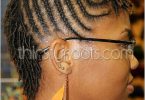When you French braid African American hair you are actually administering a method of hairstyle that is otherwise known as invisible cornrows. Ironically, the cornrow was around for centuries before the hairstyle that came to be known as the French braid. Perhaps because the cornrow belonged to primitive tribal civilizations it was lost to obscurity. Fortunately, though it has been revived through recent surges in African American awareness.
Indeed tribes from many regions of Nigeria, Egypt, and of course Africa were known to utilize this decorative hairstyle technique. You can find depictions of the cornrow, or invisible braid, style in hieroglyphs and sculptures that date back as far as 500 B.C. The most famous example of the cornrow style is contained on a sculpture that is well-known around the world: that of the majestic Sphinx in Egypt.
This style of hair was very common as an artistic practice, but it also seemed to have a cultural context as well. Some experts argue that hairstyle could have been used to distinguish one native group from another. In some cases, beads or shells may have been incorporated, which obviously then might imply that you are from a particular area along the coast.
Cornrows are very similar to the French Braid as they both involve intricately weaving strands of hair together. Cornrows use an underhand, upward motion to create braids that start tight and close to the scalp and work their way outward. They are easy to distinguish, even if the artisan administering them uses an elaborate design.
This is perhaps the most interesting feature of cornrows: that it is very common, at least these days, to find people making a fashion statement with their hair. Part of this might be due to the fact that many African America artists, entertainers, and athletes are incorporating hair patterns into their personal style.
Ironically, this is nothing new. The first time this kind of thing occurred was in the 1960s, when the Black Pride Movement and Civil Rights Movement were in full swing, attempting to create more awareness for black culture. As African Americans sought equal rights, they started to investigate their own personal and cultural identities. Out of this awareness came a desire for more traditional, natural hairstyles. As African Americans did indeed begin to retain more rights, over time, this tradition of weaving and braiding hair was passed down to younger generations.



